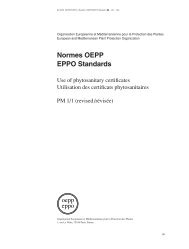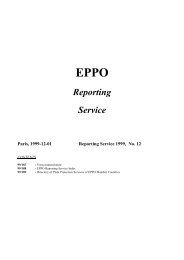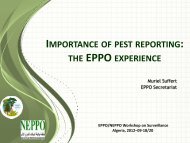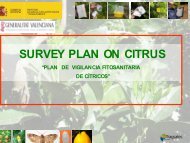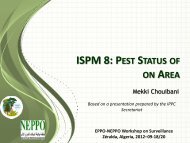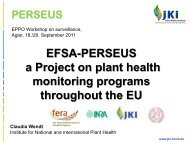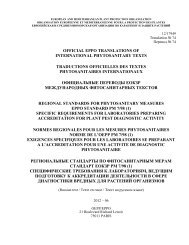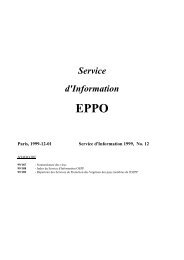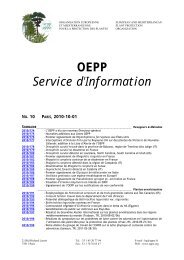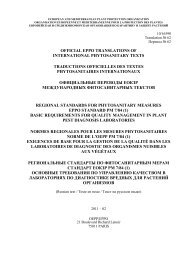EPPO Standard PM 1/2(8) - Lists of EPPO Standards - European ...
EPPO Standard PM 1/2(8) - Lists of EPPO Standards - European ...
EPPO Standard PM 1/2(8) - Lists of EPPO Standards - European ...
Create successful ePaper yourself
Turn your PDF publications into a flip-book with our unique Google optimized e-Paper software.
REQUIREMENTS<br />
The <strong>EPPO</strong> Convention lays down that one <strong>of</strong> the aims<br />
<strong>of</strong> <strong>EPPO</strong> is "to pursue and develop, by cooperation<br />
between the Member Governments, the protection <strong>of</strong><br />
plants and plant products against pests and the<br />
prevention <strong>of</strong> their international spread and especially<br />
their introduction into endangered areas". <strong>EPPO</strong><br />
Council has consequently decided to draw up lists <strong>of</strong><br />
pests whose regulation is relevant for the whole <strong>of</strong>, or<br />
large parts <strong>of</strong>, the <strong>EPPO</strong> region. The first List is <strong>of</strong> A1<br />
pests, not present in the <strong>EPPO</strong> region. The second List<br />
is <strong>of</strong> A2 pests, present in the <strong>EPPO</strong> region but not<br />
widely distributed (i.e. absent from or not widely<br />
distributed in endangered areas in certain countries,<br />
where they are therefore subject to <strong>of</strong>ficial control).<br />
Notwithstanding the above, it is accepted that certain<br />
pests appearing in the A1 and A2 <strong>Lists</strong>, though <strong>of</strong><br />
concern to some Member Governments, may not be <strong>of</strong><br />
concern to all the countries from which they are absent,<br />
and in particular that it may not be necessary or useful<br />
for all countries to take measures contributing to the<br />
protection <strong>of</strong> those countries which are at risk from<br />
these pests. Therefore, the Pest Risk Analysis process<br />
aims to identify the part <strong>of</strong> the <strong>EPPO</strong> region which is<br />
endangered.<br />
Establishment and maintenance <strong>of</strong> the A1 and<br />
A2 <strong>Lists</strong> <strong>of</strong> pests recommended for regulation<br />
as quarantine pests<br />
Addition <strong>of</strong> pests to the A1 or A2 <strong>Lists</strong><br />
<strong>EPPO</strong> started to elaborate A1 and A2 <strong>Lists</strong> in the early<br />
1970s and the first <strong>Lists</strong> were approved in 1975.<br />
Additions <strong>of</strong> pests to the A1 or A2 List were proposed<br />
by Member Governments and made on the basis <strong>of</strong><br />
scientific documentation and expert judgement. From<br />
2000 to 2006, the addition <strong>of</strong> a pest to the A1 or A2<br />
List was based on the proposal <strong>of</strong> a Member<br />
Government which provided a Pest Risk Analysis<br />
(PRA) conforming to <strong>EPPO</strong> <strong>Standard</strong> <strong>PM</strong> 5/3 Decision<br />
support scheme for quarantine pests, and supported by<br />
compilation <strong>of</strong> data according to <strong>EPPO</strong> <strong>Standard</strong> <strong>PM</strong><br />
5/1 Check-list <strong>of</strong> information required for Pest Risk<br />
Analysis. The <strong>EPPO</strong> Working Party on Phytosanitary<br />
Regulations decided, after due consideration, whether<br />
to recommend to <strong>EPPO</strong> Council the addition <strong>of</strong> a given<br />
pest to the <strong>Lists</strong>.<br />
Since 2006, a new system has been established and<br />
special expert groups have been created to conduct<br />
PRA, called Expert Working Groups (EWG) for PRA.<br />
These groups have an ad hoc membership in order for<br />
experts on specific pests to be called upon to<br />
participate when needed, as well as core members to<br />
provide consistency in conducting PRA. Core members<br />
are mainly drawn from existing <strong>EPPO</strong> Panels, and have<br />
experience <strong>of</strong> performing or reviewing risk assessment<br />
and determining risk management options. Two core<br />
members are selected for each Expert Working Group,<br />
but all core members are involved in reviewing the<br />
3<br />
documents produced by a Expert Working Group (see<br />
below). Pest Risk Analyses are carried out on pests<br />
either proposed by an <strong>EPPO</strong> Member Government or<br />
by the Panel on Phytosanitary Measures (in this case,<br />
pests are mainly selected from the <strong>EPPO</strong> Alert List).<br />
For invasive plants the Panel on Invasive Alien Species<br />
can also make proposals. The Working Party on<br />
Phytosanitary Regulations decides on priorities for<br />
PRA, but there will be enough flexibility to ensure that<br />
a PRA can be conducted on a new emerging pest even<br />
if it is not on the priority list. Pest Risk Analyses on<br />
pests are performed during the meetings <strong>of</strong> the Expert<br />
Working Group for PRA, following IS<strong>PM</strong> no. 11 and<br />
<strong>EPPO</strong> <strong>PM</strong> 5/3 Decision-support scheme for quarantine<br />
pests. The report <strong>of</strong> the PRA is prepared by the<br />
Secretariat, together with a record <strong>of</strong> the <strong>EPPO</strong><br />
decision-support scheme. These are both sent by email<br />
to all core members for review. After this consultation,<br />
the reports <strong>of</strong> the PRA are presented to the Panel on<br />
Phytosanitary Measures which makes appropriate<br />
recommendations to the <strong>EPPO</strong> Working Party on<br />
Phytosanitary Regulations. The Working Party on<br />
Phytosanitary Regulations decides, after due<br />
consideration, whether to recommend to <strong>EPPO</strong> Council<br />
the addition <strong>of</strong> a given pest to the List.<br />
Deletion <strong>of</strong> pests from the A1 or A2 List<br />
When new information concerning a pest is reviewed<br />
by the Panel on Phytosanitary Measures and leads to<br />
the conclusion that the phytosanitary risk has changed<br />
and its management as a regulated pest is no longer<br />
justified, the Panel on Phytosanitary Measures<br />
recommends to the Working Party that the pest should<br />
be deleted from the A1 or A2 List. The <strong>EPPO</strong> Working<br />
Party on Phytosanitary Regulations decides, after due<br />
consideration, whether to recommend to <strong>EPPO</strong> Council<br />
the deletion <strong>of</strong> a given pest from the List.<br />
Transfer <strong>of</strong> pests from the A1 to the A2 <strong>Lists</strong><br />
The transfer <strong>of</strong> a pest from the A1 to the A2 List, or<br />
vice versa, is decided by the Working Party on the<br />
basis <strong>of</strong> adequate documentation justifying the change<br />
in status. The <strong>EPPO</strong> Working Party on Phytosanitary<br />
Regulations decides, after due consideration, whether<br />
to recommend to <strong>EPPO</strong> Council the transfer <strong>of</strong> a given<br />
pest.<br />
A1 and A2 <strong>Lists</strong><br />
These <strong>Lists</strong> are presented in Appendix 1.




